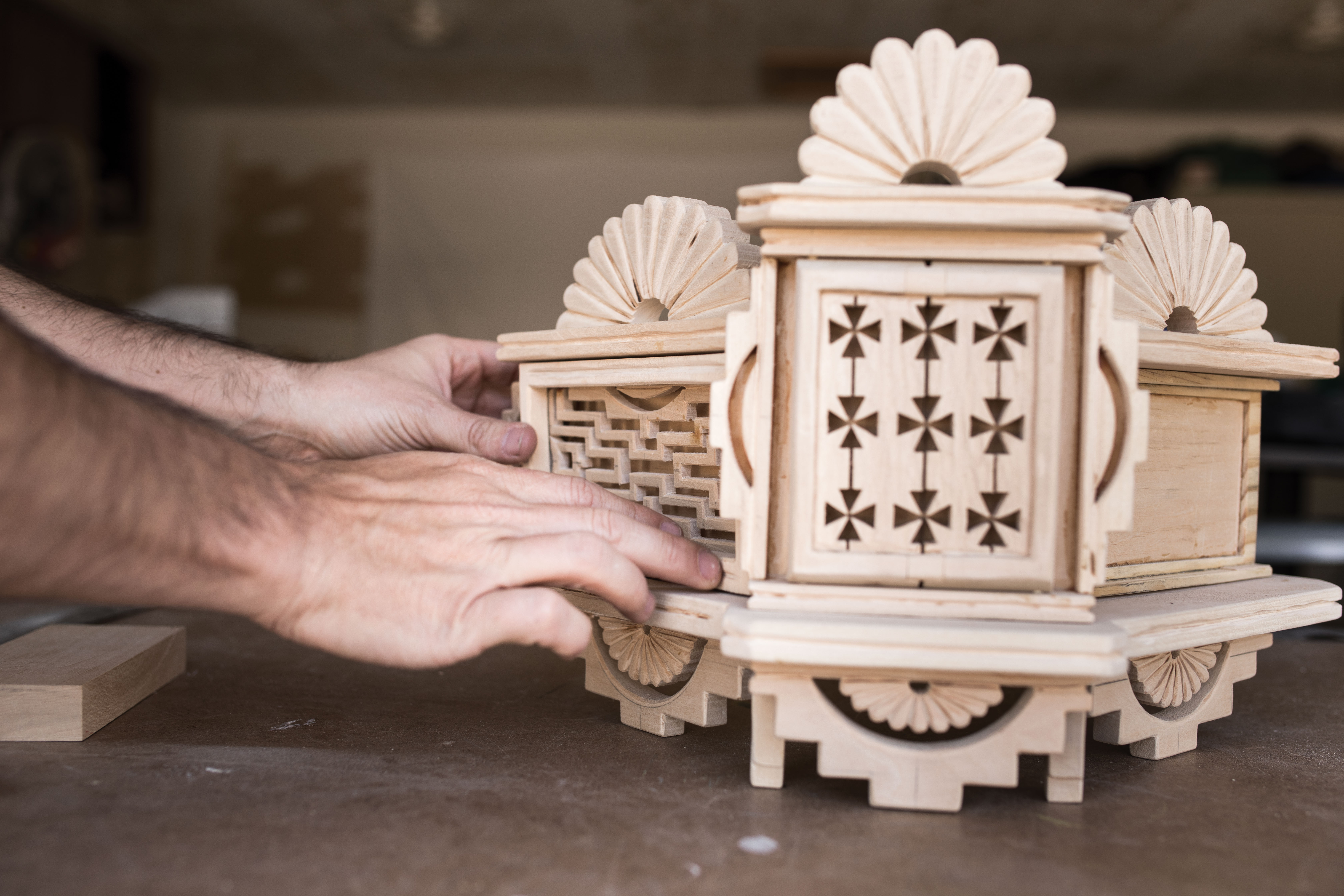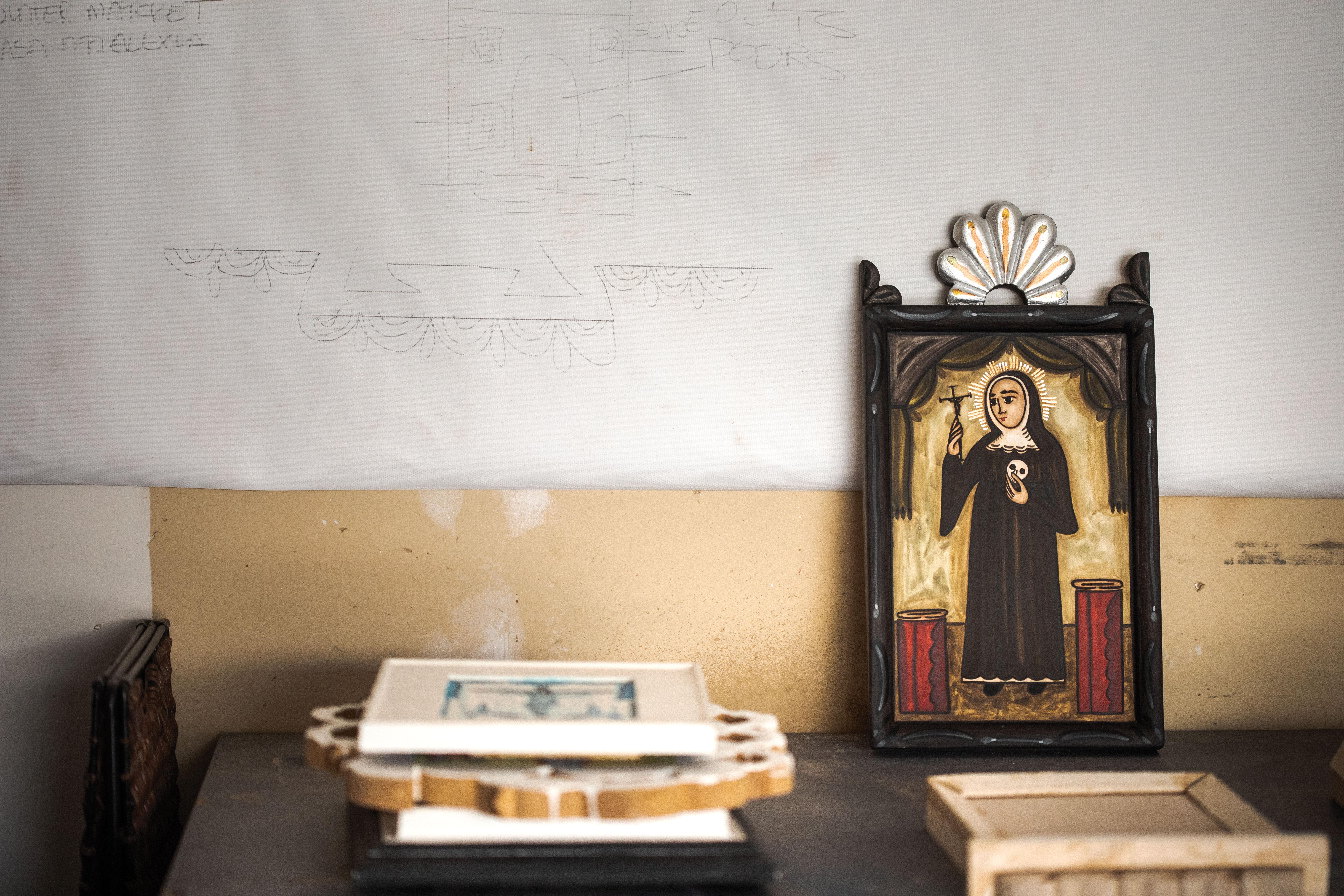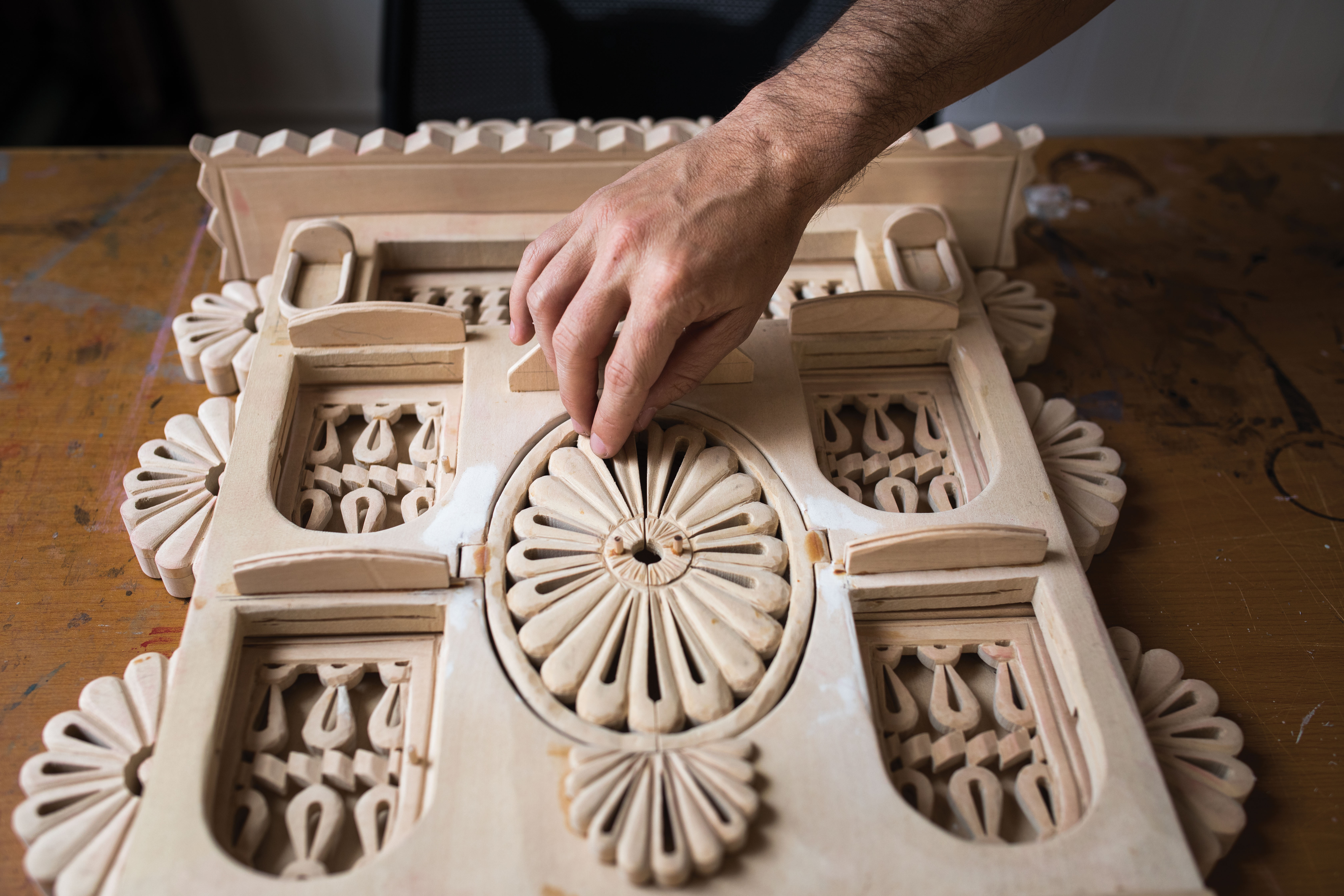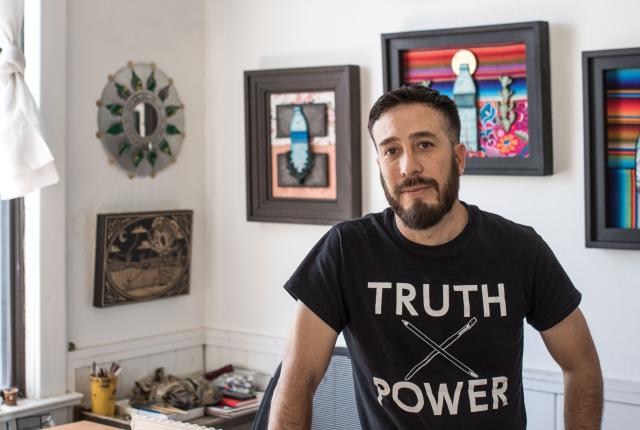Above: Vicente Telles. Photograph by Minesh Bacrania.
ON THE SECOND FLOOR of a 110-year-old building in downtown Albuquerque, Vicente Telles sits in a group of contemporary art studios, his surroundings a physical metaphor for the worlds that define him: old and new, traditional and contemporary, devoted santero one day, edgy iconoclast the next.
There, above Brixens restaurant and bar, at Fourth Street and Central Avenue, he walks across a paint-splattered floor to retrieve an intricately carved Spanish colonial–style wooden altarpiece with delicately hinged shutters. Its unblemished surface awaits the natural pigments of his paintbrush and then entry into Traditional Spanish Market, July 27–28 on the Santa Fe Plaza.
Over at his work table, paints, stretched canvases, and serape blankets will soon deliver different multimedia statements, ones as lighthearted as an ode to a paleta and as hard-charging as Jesus’ body transfigured into a Samaritan’s water jug. That painting, Agua de Vida, represents the anonymous gifts of water left for desert border crossers that are often slashed by immigration foes. In Telles’ version, the cuts in the jug represent the wounds to Christ’s body. A gleaming gold disk tops the bottle, reminding viewers to seek their reflection in the divine.
These are the kinds of pieces he does the rest of the year, beyond Spanish Market and its tradition-bound tenets.
“I’m coming up on my third year in Traditional Spanish Market, and I buck the rules,” he says. “For two years, I’ve been told that I need to do this, do that. But how do you preserve something without moving it forward?”
Telles isn’t the first to ask the question, and he won’t be the last. As part of the Chicano art movement of the 1970s, Luis Tapia began defining new ways of melding tradition with modernity’s challenges. That evolution later drew artists like Nicholas Herrera and Arthur López, who adapted religious symbols to speak in new ways. One put a handcuffed Christ into a police car, some celebrated lowrider culture, and many held barbed riffs on technology, substance abuse, or the inherent power of women to be more than docile saints.
 Above: An altarpiece.
Above: An altarpiece.
Growing up in Albuquerque’s South Valley, Telles knew nothing of santeros or their art. The child of working-class parents, he rarely went to church, didn’t take art classes while attending Rio Grande High School, and didn’t think he would rise above a persistent sense of being the underdog. “I feel like all of us at Rio insulated ourselves, like we had a chip on our shoulder,” he says. “I come from a place that may be economically lacking, but it’s not poor. It’s very rich in tradition, pride, work ethic. I’ve been fortunate to be surrounded by people who are fighters and intelligent and do the right thing.”
He was happily enrolled in UNM, aiming for a career as a teacher, when a Chicano studies professor made an offhand remark about santeros. That spurred Telles into haunting libraries and used bookstores for information. As he began to pluck at a centuries-old cultural link to his own neighborhood, he decided to pick up a paintbrush. “I wasn’t very good,” he admits of his early efforts. But he quietly stuck with it, even as he walked away from college for a job in California with a manufacturing firm that supplied home decor to places like Hobby Lobby and Ashley Furniture. There, he learned about color technique and how texture can make a visual statement.
By 2006 he was reinterpreting religion through the lens of comic books and painting onto metal surfaces. One day, someone asked if his work would be at Spanish Market. “I didn’t even know what it was,” he says. He put together some pieces and entered a show in Albuquerque’s Old Town, where his shock at winning a category was eclipsed by discovering that the santeros he had been studying “exist in real life. I was like, Whoa.”
Their shared art form blossomed in New Mexico and southern Colorado in the 18th century, when occasional caravans of supplies from Mexico City were stuffed with necessities but only rarely brought canvases, oil paints, and marble blocks. Artists bolstered the meager supplies with cottonwood and pine roots to form bultos, or statues. For paint, they liquified the pigments they found in soils, crushed rocks, plants, even insects, which they brushed onto tanned hides and wood panels. They devised ways to make straw mimic luxury materials like mother-of-pearl, embedding it into the designs on crosses. When U.S. soldiers brought tin cans with them in the 1840s, the artists recycled them into frames and candleholders so fine that the material came to be called “poor man’s silver.”
 Above: A retablo of Santa Rita.
Above: A retablo of Santa Rita.
Since 1925, the Spanish Colonial Arts Society has sought to revive and preserve those art forms, codifying requirements for materials, subject matter, and techniques. By 1986, enough artists had chafed at the rules to create an independent Contemporary Hispanic Market, which occurs the same weekend. Telles participated in it for several years until making the switch to Traditional Spanish Market. In 2011, the Spanish Colonial Arts Society debuted an Innovations Within Tradition category, available only to artists who had proved themselves worthy practitioners of the old techniques in two prior markets and now sought a second level of approval.
Telles, whose contemporary work was included in the Museum of Spanish Colonial Art’s recent exhibit GenNext: Future So Bright and is currently part of an exhibit called Borderless: Art Sin Fronteras in Denver’s History Colorado Center, tried to crack into the Innovations category this year. He didn’t make it. That’s not uncommon, says Jana Gottshalk, GenNext’s curator; people generally apply two or three times.
“I think Vicente is going to become nationally appreciated, if not internationally,” she says. “I think he has the potential to be part of a new movement.”
That movement is under way. Evoke Contemporary, in the Santa Fe Railyard Arts District, carries boundary-breaking work that ranges from Thomas Vigil’s spray-painted highway signs to Patrick McGrath Muñiz’s sly cultural critiques in paintings rendered with an old master’s sensibilities. “You can’t stop the river,” gallerist Susan Guevara says. “The biggest thing about the santero tradition is that they were developing and creating new pigments and materials from the get-go. This is just a continuation.”
 Above: Another altarpiece.
Above: Another altarpiece.
In the painting La Sagrada Familia, Telles depicts an airborne Mary, Joseph, and a boy-age Jesus as comic-book superheroes. “The World’s Mightiest Family,” it proclaims. “Fly with Us!!” In Malinche, he rescues the Nahuatl translator for conquistador Hernán Cortés from her maligned roles as victim and/or traitor. Instead, he sees her as a feminist heroine—smart, brave, the mother of mestizos and Genízaros, the enduring and conflicted mix of European and indigenous peoples. He recently began incorporating Mexican serapes into his paintings as a way of giving voice to immigrants: “I’m not accepted here, they’re kicking me out, but what I bring is beautiful,” Telles says of his message
“Each painting we do has a chance to fall in line or start a narrative,” he says. “How do we create our narrative now? By telling the hard truths, not sweeping things under the rug. What I got out of my Catholic confirmation was: If you’re not questioning, then you’ve stopped learning, you’ve stopped participating.”
Read more: Our Photos of the Year—The New Mexico Magazine 2019 Photo Contest Winners
As for Gottshalk’s notion that he is part of a new wave of artists, Telles laughs. “I’m not young. I’m 36.” He reaches down now to younger artists, partly through his participation in Albuquerque’s Working Classroom program, which gives middle and high schoolers an opportunity to take art classes from well-known artists in the community and as far away as Mexico. Among the advice he shares: “You have to ground yourself before you can grow. You have to be educated in the tradition or you’re just doing things for shock value. It can become kitsch.”
To that end, he ventures into museum vaults, paying attention to color palettes, faces, and the accoutrements of the saints. “How do I adapt it, bring the mestizaje tradition into it?” he says of his drive to connect another artist’s past to his present. “What I missed most when I was living in California was driving down the road and waving at the parents of someone I went to school with. I want to create something so that the families I know realize they contributed to it.”

MARKET DAYS
Traditional Spanish Market, July 27–28, packs the Santa Fe Plaza with about 250 artists, including santeros, weavers, blacksmiths, and jewelers. The Spanish Colonial Arts Society’s ¡Viva La Cultura! week, July 22–26, bursts with music, book signings, and artist studio tours.
On the same weekend, Contemporary Hispanic Market packs about 150 artists arrayed onto Lincoln Avenue, adjacent to Traditional Spanish Market artists. A number of Santa Fe galleries spotlight special exhibits in conjunction with the markets. Two to check out:
Pop Gallery hosts a pop-up show on July 27–28, which includes six large-scale paintings by Brandon Maldonado that explore Spain’s 1692 reconquest of Santa Fe from different points of view (125 Lincoln Ave.; Santa Fe).
Evoke Contemporary debuts Sin Fronteras, July 6–August 24, with works by Nicholas Herrera, Thomas Vigil, and Patrick McGrath Muñiz (550 S. Guadalupe St.; Santa Fe).


